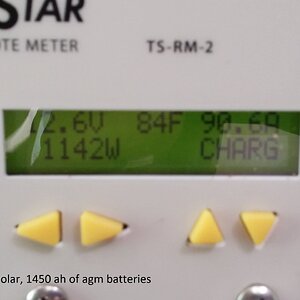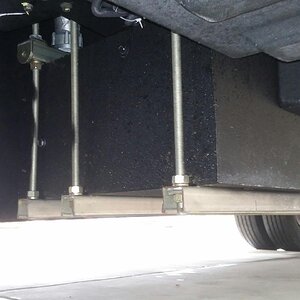bpaikman
RVF Supporter
- Joined
- Jun 25, 2020
- Messages
- 1,078
- Location
- Lake Jackson, Texas
- RV Year
- 2014
- RV Make
- Newmar
- RV Model
- Ventana LE 3436
- RV Length
- 35 feet
- Chassis
- Freightliner
- Engine
- Cummins 340 hp
- TOW/TOAD
- 2013 Subaru Crosstrek - manual, flat tow
- Fulltimer
- No
1. First noticed an indicator light on the surge protector that warned overheating. Everything else was green (50 amp)
2. Inspected and found indications of overheating (slight warping)
at the shore power plug,
and each end of the 120 foot 50-amp extension cable,
and the surge protector
.... no indication of overheating at the house outlet. where we plug in when loading RV.
3. electrician came out and inspected it found a loose prong on the shore power plug from the RV. that prong corresponded with every plug that showed heat damage. He believes that is the cause of all the trouble. However he did tell us it was a very hot day.. that's a black cable lying out there in the sun. He thought it might still work. indeed, it was working fine at the time. No alarms in the coach ....we were running 2 ACs on a 95° day with 100,000% humidity.
an electrician for the same company is coming out tomorrow to replace the plug with the loose prong. They think everything else will be all right. In other words tomorrow when we are loading for our 3-month trip we could start running the refrigerator and air conditioners, using the same heat damaged extension cord. (we have already replaced the damaged surge protector).
4. What do you think? Do you think that prong caused all that melting? The damaged places are warped, with no black.
after he replaces the shore power connection plug, we should be good to go for a trip. What we are wondering is could we still use the extension cord and New surge protector.
We cannot replace the connections on each end of the extension cord at this time ..because some parts have to be ordered and we are due to leave Tuesday.
In an abundance of caution, we're considering running the generator to finish loading. But we're worried about the neighbors.
this guy is a professional electrician that works for large company in town, but he only did a visual inspection and to him it looks fine. we're just very leery of a possible electric fire.
2. Inspected and found indications of overheating (slight warping)
at the shore power plug,
and each end of the 120 foot 50-amp extension cable,
and the surge protector
.... no indication of overheating at the house outlet. where we plug in when loading RV.
3. electrician came out and inspected it found a loose prong on the shore power plug from the RV. that prong corresponded with every plug that showed heat damage. He believes that is the cause of all the trouble. However he did tell us it was a very hot day.. that's a black cable lying out there in the sun. He thought it might still work. indeed, it was working fine at the time. No alarms in the coach ....we were running 2 ACs on a 95° day with 100,000% humidity.
an electrician for the same company is coming out tomorrow to replace the plug with the loose prong. They think everything else will be all right. In other words tomorrow when we are loading for our 3-month trip we could start running the refrigerator and air conditioners, using the same heat damaged extension cord. (we have already replaced the damaged surge protector).
4. What do you think? Do you think that prong caused all that melting? The damaged places are warped, with no black.
after he replaces the shore power connection plug, we should be good to go for a trip. What we are wondering is could we still use the extension cord and New surge protector.
We cannot replace the connections on each end of the extension cord at this time ..because some parts have to be ordered and we are due to leave Tuesday.
In an abundance of caution, we're considering running the generator to finish loading. But we're worried about the neighbors.
this guy is a professional electrician that works for large company in town, but he only did a visual inspection and to him it looks fine. we're just very leery of a possible electric fire.












